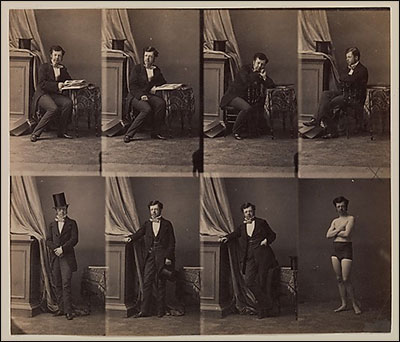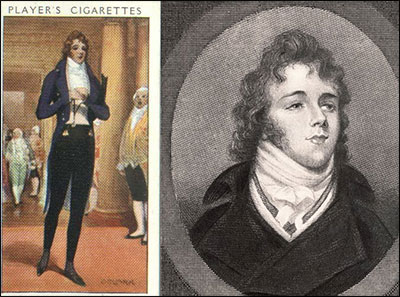The Evolution of Fashion as a Signifier
Coilhouse guest blogger Numidas Prasarn previously brought you an article on Fe Maidens, the all-girl high school robotics team from the Bronx. In her second guest post on Coilhouse, Numi talks about fashion as a signifier of status and identity, and how the emergence of the middle class, along with globalization, have changed the pace at which fashion trends are manufactured, adopted and discarded. Numi demonstrates this phenomenon by walking us through the evolution of the men’s three-piece suit. An academic #longread sure to delight fashion/history/socioeconomics geeks! If you enjoyed “Starch Makes the Gentlemen” and “Teddy Boys,” this article provides some excellent context. – Nadya

Prince Lobkowitz, 1858
Fashion as signifier is a concept familiar to many that identify as part of an alternative tribe or culture. How we express ourselves, how we identify with those around us, what style says about us and our culture – fashion is often examined through this scope. But how do we explain the origin of how trends in fashion move, how do we create these signifiers to begin with? There are many ways to approach this, one angle is the idea that fashion and socioeconomics are inseparable, that style and social politics are more intertwined than initially imagined and more specifically that globalization and the growth and reign of the middle class changed the game of fashion.
That is an awfully heavy statement to lay in one sentence.
Allow me to back up for a moment. There is a list of reasons designed to answer “Why do humans wear clothing.” They are Protection, Modesty, Identification, Adornment, and Status. Right now I am going to focus on Identification and Status, particularly in relation to using fashion as a means of establishing class division. German sociologist Georg Simmel puts it in terms of Imitation, Union and Exclusion. He writes that:
“Fashion is the imitation of a given example and satisfies the demand for social adaptation […] At the same time it satisfies in no less degree the need of differentiation, the tendency towards dissimilarity, the desire for change and contrast, on the one hand by a constant change of contents, which gives to the fashion of to-day an individual stamp as opposed to that of yesterday and of tomorrow, on the other hand because fashions differ for different classes – the fashions of the upper stratum of society are never identical with those of the lower; in fact, they they are abandoned by the former as soon as the latter prepares to appropriate them.” [1]
Up until the 20th century, the largest shifts in style, silhouette and beauty have been directly linked with the changes of the ruling class. A trend established by the aristocracy and shared amongst themselves, it becomes a marker establishing what class the wearer belongs to. It is therefore a means of creating Status and allowing Identification, and on a deeper level creating an environment of Exclusion/Inclusion.
The game changes completely with the entrance of the middle class. After the Industrial Revolution but before WWI, you see an interesting shift start to happen where importance in the aristocracy turns instead to the working class. The idea of the self-made man and the nouveau riche become the new aristocracy and the middle class undergoes a growth spurt. Still young in its identity, it upholds a lot of the ideals it was taught to value and is a prime example of Simmel’s concept of Imitation. Post WWI, the notion of an aristocratic ruling class dies and so ideals change. From here on out, changes in trends happen faster and in a more cyclical manner. It isn’t that we ran out of ideas or new needs, we merely established that upward mobility was possible and therefore trends became more accessible. To use Simmel’s terms again, Imitation and Inclusion became possible on a wider scale which meant Exclusion had to happen at a faster rate.
Let’s demonstrate by examining the evolution of the male wardrobe, specifically the reign of the 3-piece suit.
We have images of masculine attire through the ages as being playful at some points, and completely dour and boring at others, with it ultimately landing on the latter. English psychologist John Carl Flugel coined the term for this phenomenon as “The Great Masculine Renunciation”. He writes, “modern man’s clothing abounds in features which symbolize his devotion to the principles of duty, of renunciation, and of self control.”[2] Changes in political attitudes and values pinned masculinity into this mode of restraint starting with 17th century France. And not to beat a dead french horse, but the death of the aristocracy was just the first nail in the coffin. After the French Revolution, specific signs of nobility and class distinction were shunned and in some cases outright outlawed. Which isn’t to say that in their push for liberty and equality in the Napoleonic era class distinction and social hierarchy did NOT exist, only that showing specific signs of flamboyance or excess, characteristics of the bourgeoisie, was unacceptable. And so we reach a period of uniformity and reserve in masculine dress, as Flugel puts it “Man abandoned his claim to be considered beautiful. He henceforth aimed at being only useful.”

French evolution of menswear.
On the flipside, in the English Regency, there are two major factors that contributed to this change – the Age of Enlightenment and the quintessential dandy, Beau Brummell. England at this point is engaged in constant war between Napoleon, its own efforts at expansion, and itself (Hey, America!) and the French Revolution along with the philosophical writings of the time jump start this trend of neoclassicism. For men, this means a “sleeker” silhouette, to highlight the male body and echo the idealized physique in greek sculpture. Suddenly elaborate trims and ornamentation is left out and the quality of tailoring and cut of cloth is emphasized in such a way that implied the fitness and virility of the wearer (important also in a growing military culture). Beau Brummell takes this silhouette and runs with it, becoming the poster boy for men’s fashion. He is so influential as a style icon that it is often credited to him that we see the modern suit form, the dark colors and precise tailoring, starched crisp collar and a well placed necktie all from his cue (which he took from the french idealization of working class aesthetics).
So ok, we’ve established the development of the male uniform, now what? The call for women’s dress reform eventually reverts back to more restricted garments and exaggerated silhouettes, and therefore further ornamentation in dress is explored (this time to get away from any association with Napoleon). So what happened to masculine identity in the following Victorian era? The Industrial Revolution and the rise of free-market capitalism became the final nails in the coffin. Jumping from the military to the factory, with a focus on establishing status through industry never left room for ornamentation and play in the male wardrobe. And then came more war (the great equalizer), the great depression, and a second helping of more war. And while massive changes in women’s clothing paralleled their shifting role in society, changes to male fashion mostly fell back on how trim or muscular the current mood fell on.

Beau Brummel
Men’s fashion shuffles slowly from this point. Suddenly the past-paced play of Inclusion/Exclusion, globalization and the speed at which information is shared blows open the playing field and yet again the lens through which masculinity and fashion is examined changes. At this point we start to see pockets of change in masculine identity largely because of the shift in feminine identity. That is the new conversation to be had. Suddenly the female gaze becomes more powerful in our timeline, and changes in priority from family to work also changes the idea of leisure which is important to the development of certain aspects of style. The idea of play and the value of ornamentation once again has a chance to be a focus, breathing new life into menswear, though only in specific pockets of society.
We are in an age where uncertainty is key, and ideas are memes, infiltrating and dissipating into culture almost instantaneously. All fashion has now is play and this I believe to be important in identity forming. Knowing how trends and signifiers move, how do you play with fashion and what does that say about you?
[1] – Simmel, Georg. “Fashion” International Quarterley 10 (1904), 130-155
[2] – Flugel, John C. The Psychology of Clothes. London: Hogarth Press, 1930

November 16th, 2012 at 11:06 am
[…] Exploring the idea of fashion as a signifier. Cancel […]
November 19th, 2012 at 10:21 am
[…] Full Story: Coilhouse: The Evolution of Fashion as a Signifier […]